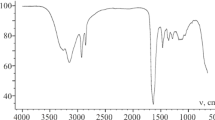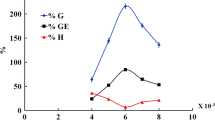Abstract
The aim of this study was to obtain new water-soluble polyguanidines, assess their antimicrobial properties with respect to the test objects of Escherichia coli and Bacillus cereus and establish the hazard class regulated in the territory of the Russian Federation. Polymers obtained in high yields by the method of polycondensation in the melt of the corresponding monomers and characterized by the methods of IR spectroscopy and elemental analysis. Serial dilution–agar plate procedure was performed in order to estimate antibacterial effects. The biocidal properties of the samples were estimated by the percentage reduction of microorganisms (% reduction). To determine the acute toxicity, a toxicometric assessment and symptoms of intoxication upon oral administration of a single dose were carried out in laboratory animals. New water-soluble guanidine-containing polymers with a number average molecular weight of 660–1040 Da were obtained. Copolymers with a low degree of substitution (10–20%) exhibit high antimicrobial activity among N-phenyl-substituted samples. As a result of the substituent increase in the polymer chain, their activity in relation to the studied bacteria is linearly decreased to a level comparable to the test sample. In contrast to the N-octyl-substituted copolymers, gram-positive bacterium B. cereus is more susceptible to N-phenyl-substituted samples. Substances after intragastric injection belong to the fourth class of toxicity (LD50 > 300 ≤ 2000 mg/kg) according to the requirements of tabulation of toxicity classes regulated in the territory of the Russian Federation. The combination of low toxicity with a high level of antibacterial activity of new guanidine-containing polymers suggests the possibility of obtaining new effective disinfectants.



Similar content being viewed by others
Availability of data and materials
The data analyzed during the study will be available from the corresponding authors upon request.
Abbreviations
- PHMG:
-
Polyhexamethyleneguanidine
- PHMGHC:
-
PHMG hydrochloride
- HMDA:
-
Hexamethylenediamine
- GHC:
-
Guanidine hydrochloride
References
Vijayakumar R, Sandle T (2019) A review on biocide reduced susceptibility due to plasmid-borne antiseptic-resistant genes—special notes on pharmaceutical environmental isolates. J Appl Microbiol 126(4):1011–1022
Yoo JH (2018) Review of disinfection and sterilization–back to the basics. Infect Chemother 50(2):101–109
Oblak E, Piecuch A, Rewak-Soroczynska J et al (2019) Activity of gemini quaternary ammonium salts against microorganisms. Appl Microbiol Biotechnol 103(2):625–632
Shkarin VV, Sparkin NV, Kovalishin OV et al (2012) The regional monitoring of microorganisms resistance to disinfectants: results and perspectives. Med Almanah 22(3):122–125
Vointseva II, Gembitskiy PA (2009) Poliguanidiny—dezinfektsionnyye sredstva i polifunktsional'nyye dobavki v kompozitsionnyye materialy. LKM-Press, Moskva
Efimov KM, Gembickii PA, Snezhko AG (2000) Polyguanidines a class of low-toxic long-acting disinfectants. Des Case 4:32
Stelmakh SA, Bazaron LU, Mognonov DM (2010) About the mechanism of polycondensation of hexamethylenediamine and guanidine hydrochloride. Russ J Appl Chem 83(2):342–344
Grigorieva MN, Stelmakh SA, Astakhova SA et al (2015) Synthesis of polyalkylguanidine hydrochloride copolymers and their antibacterial activity against conditionally pathogenic microorganisms Вacillus Cereus and Еscherichia Сoli. Pharm Chem J 49(2):29–33
Mamonova IA (2013) Vliyaniye nanochastits perekhodnoy gruppy metallov na antibiotikorezistentnyye shtammy mikroorganizmov: Avtoref. dis. kand. biolog. nauk: 03.02.03/Mamonova Irina Aleksandrovna; RUDN: M, p 23
Rukovodstvo R (2014) 1.2.3156-13, Fed. tsentr gigiyeny i epidem. Rospotrebnadzora, Moskva, pp 32–46
Russian GOST 32644-2014 (2015) STANDARTINFORM: Moscow, p 12
Mironov AN, Bunatyan ND et al (2012) Rukovodstvo po provedeniyu doklinicheskikh issledovaniy lekarstvennykh sredstv. In: Grif IK (eds) Chapter 1. Moscow, pp 13–17
Pershin GK (1971) Methods of experimental chemotherapy: practical guidance, 2nd edn. Medicina, Moscow
Prozorovskii VB (2007) Statistic processing of data of pharmacological investigations. Psychofarmacol Biol Narcol 7(3–4):2090–2120
Nakanisi K (1965) Infrared spectra and the structure of organic compounds. MIR, Moscow
Goto T, Nakanishi K, Ohashi N (1957) An account on the infrared absorption of guanidiniums. Bull Chem Soc Jpn 30(7):723–725
Tsydenova O, Batoev V, Batoeva A (2015) Solar-enhanced advanced oxidation processes for water treatment: simultaneous removal of pathogens and chemical pollutants. Int J Environ Res Public Health 12:9542–9561
Khankhasaeva ST, Dambueva DV, Dashinamzhilova ET, Gil A, Miguel AV, Timofeeva MN (2015) Fenton degradation of sulfanilamide in the presence of Al, Fe-pillared clay: catalytic behavior and identification of the intermediates. J Hazard Mater 293:21–29
Michiels J, Xi C, Verhaert J, Vanderleyden J (2002) The functions of Ca2+ in bacteria: a role for EF-hand proteins? Trends Microbiol 10(2):87–93
Qian LY, Guan Y, He BH, Xiao HN (2008) Modified guanidine polymers: synthesis and antimicrobial mechanism revealed by AFM. Polymer 49(10):2471–2475
Funding
The study was performed in the framework of the state assignment of Baikal Institute of Nature Management of SB RAS.
Author information
Authors and Affiliations
Contributions
SS, SL and MG designed the study, collected and analyzed the data, drafted the paper and supervised the overall work. MG, NG and OO contributed on the data collection and statistical analysis. SS reviewed the study design. DM, SZ and VB contributed on the interpretation of the data and the study design of the paper and approved the manuscript. All authors have accepted and approved the final version of the manuscript.
Corresponding author
Ethics declarations
Conflict of interest
The authors declare that they have no competing interests.
Additional information
Publisher's Note
Springer Nature remains neutral with regard to jurisdictional claims in published maps and institutional affiliations.
Rights and permissions
About this article
Cite this article
Stelmakh, S.A., Grigor’eva, M.N., Garkusheva, N.M. et al. Studies of new biocidal polyguanidines: antibacterial action and toxicity. Polym. Bull. 78, 1997–2008 (2021). https://doi.org/10.1007/s00289-020-03197-1
Received:
Revised:
Accepted:
Published:
Issue Date:
DOI: https://doi.org/10.1007/s00289-020-03197-1




